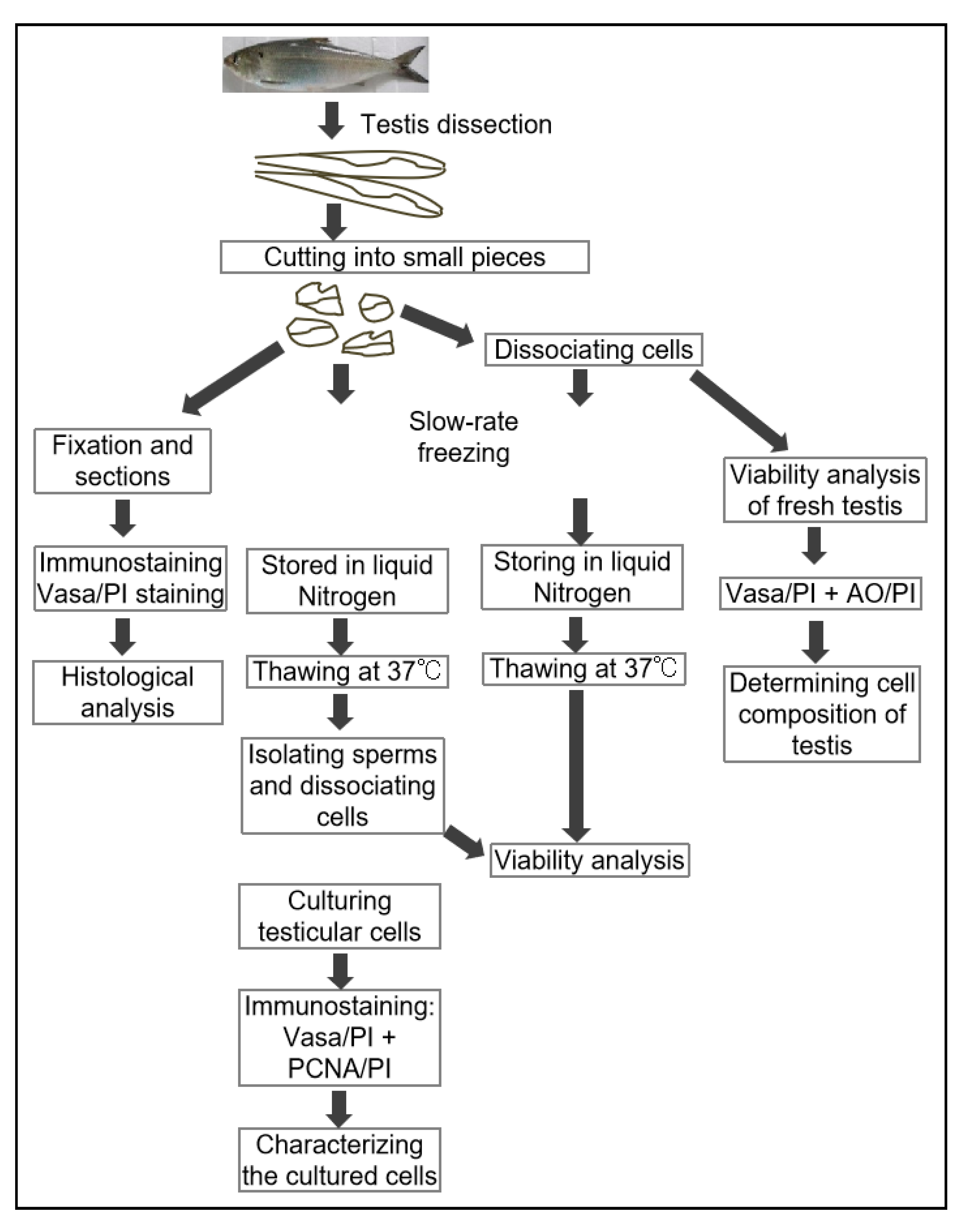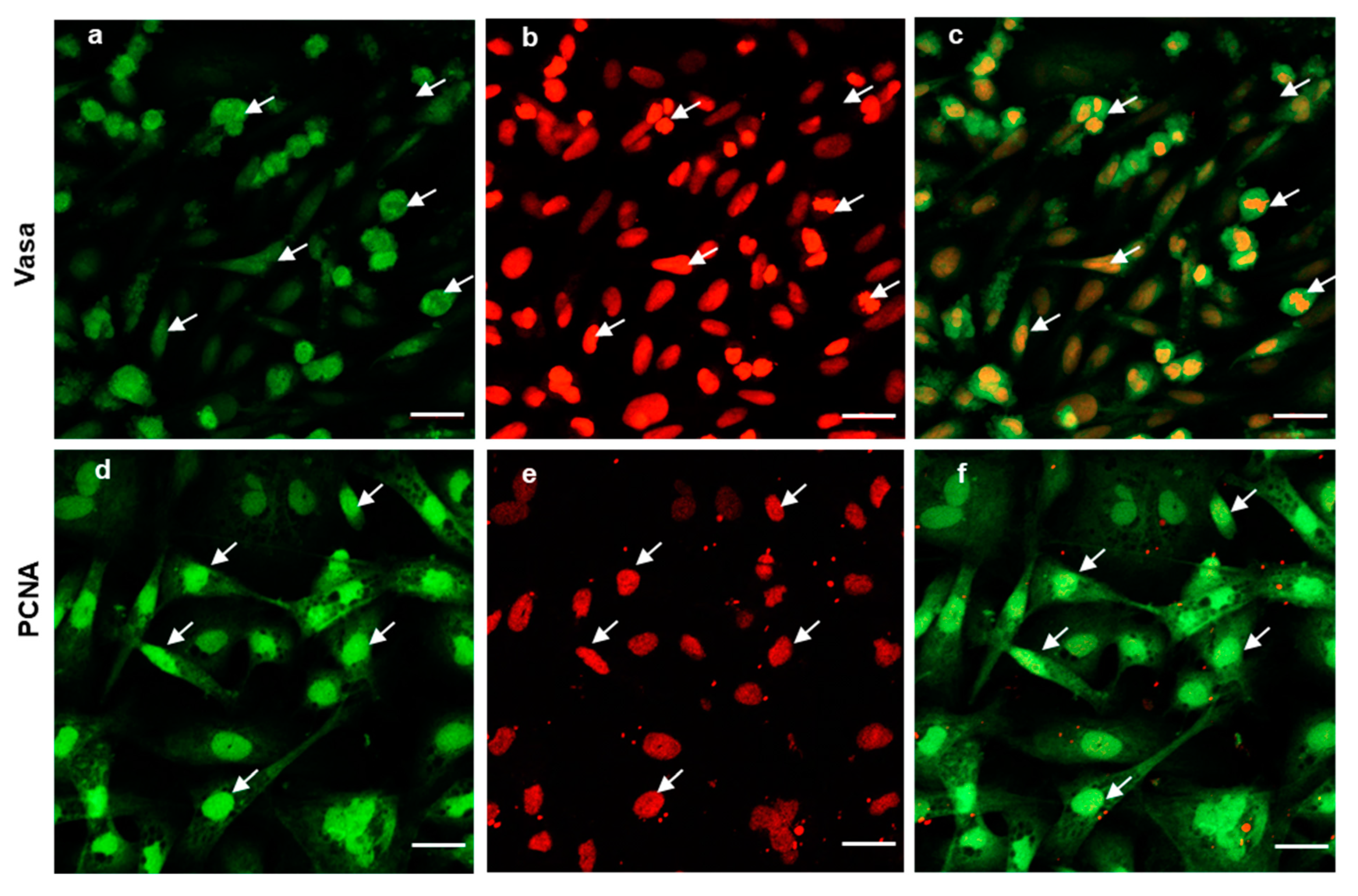Restoring Genetic Resource through In Vitro Culturing Testicular Cells from the Cryo-Preserved Tissue of the American Shad (Alosa sapidissima)
Abstract
Simple Summary
Abstract
1. Introduction
2. Materials and Methods
2.1. Fish and Samples
2.2. Cryopreservation of Testicular Tissues and Cells
2.3. Immunocytochemistry
2.4. Assessment of Cell Viability
2.5. In Vitro Culture of the Testicular Cells from Cryopreserved Samples
2.6. Statistical Analysis
3. Results
3.1. The Cellular Composition of American Shad Testes

3.2. Cryopreservation of Testicular Cells and Tissues
3.3. Validation of the Cryopreservation Method with Another Batch of Samples
3.4. Cell Proliferation of Cryopreserved Tissue
4. Discussion
5. Conclusions
Supplementary Materials
Author Contributions
Funding
Institutional Review Board Statement
Informed Consent Statement
Data Availability Statement
Conflicts of Interest
References
- Xu, H.; Li, M.; Gui, J.; Hong, Y. Fish germ cells. Sci. China Life Sci. 2010, 53, 435–446. [Google Scholar] [CrossRef] [PubMed]
- Chuma, S.; Kanatsu-Shinohara, M.; Inoue, K.; Ogonuki, N.; Miki, H.; Toyokuni, S.; Hosokawa, M.; Nakatsuji, N.; Ogura, A.; Shinohara, T. Spermatogenesis from epiblast and primordial germ cells following transplantation into postnatal mouse testis. Development 2005, 132, 117–122. [Google Scholar] [CrossRef] [PubMed]
- Saitou, M.; Yamaji, M. Primordial germ cells in mice. Cold Spring Harb. Perspect. Biol. 2012, 4, a008375. [Google Scholar] [CrossRef] [PubMed]
- Tonus, C.; Connan, D.; Waroux, O.; Vandenhove, B.; Wayet, J.; Gillet, L.; Desmecht, D.; Antoine, N.; Ectors, F.J.; Grobet, L. Cryopreservation of chicken primordial germ cells by vitrification and slow-freezing: A comparative study. Theriogenology 2017, 88, 197–206. [Google Scholar] [CrossRef]
- Yoshizaki, G.; Lee, S. Production of live fish derived from frozen germ cells via germ cell transplantation. Stem Cell Res. 2018, 29, 103–110. [Google Scholar] [CrossRef]
- Martinez-Paramo, S.; Horvath, A.; Labbe, C.; Zhang, T.; Robles, V.; Herraez, P.; Suquet, M.; Adams, S.; Viveiros, A.; Tiersch, T.R.; et al. Cryobanking of aquatic species. Aquaculture 2017, 472, 156–177. [Google Scholar] [CrossRef]
- Mauger, P.E.; Le Bail, P.Y.; Labbe, C. Cryobanking of fish somatic cells: Optimizations of fin explant culture and fin cell cryopreservation. Comp. Biochem. Physiol. Part B Biochem. Mol. Biol. 2006, 144, 29–37. [Google Scholar] [CrossRef]
- Kawakami, Y.; Goto-Kazeto, R.; Saito, T.; Fujimoto, T.; Higaki, S.; Takahashi, Y.; Arai, K.; Yamaha, E. Generation of germ-line chimera zebrafish using primordial germ cells isolated from cultured blastomeres and cryopreserved embryoids. Int. J. Dev. Biol. 2010, 54, 1493–1501. [Google Scholar] [CrossRef]
- Higaki, S.; Mochizuki, K.; Akashi, Y.; Yamaha, E.; Katagiri, S.; Takahashi, Y. Cryopreservation of primordial germ cells by rapid cooling of whole zebrafish (Danio rerio) embryos. J. Reprod. Dev. 2010, 56, 212–218. [Google Scholar] [CrossRef]
- Lee, S.; Iwasaki, Y.; Shikina, S.; Yoshizaki, G. Generation of functional eggs and sperm from cryopreserved whole testes. Proc. Natl. Acad. Sci. USA 2013, 110, 1640–1645. [Google Scholar] [CrossRef]
- Pšenička, M.; Saito, T.; Rodina, M.; Dzyuba, B. Cryopreservation of early stage Siberian sturgeon Acipenser baerii germ cells, comparison of whole tissue and dissociated cells. Cryobiology 2016, 72, 119–122. [Google Scholar] [CrossRef] [PubMed]
- Elzey, S.P.; Rogers, K.A.; Trull, K.J. Comparison of 4 aging structures in the American shad (Alosa sapidissima). Fish. Bull. Natl. Ocean. Atmos. Adm. 2015, 113, 47–54. [Google Scholar] [CrossRef]
- Tang, G.; Huang, A.; Wei, Q. The resource fluctuations and restoration of American shad (Alosa sapidissima). J. Hydroecology 2010, 3, 130–134. (In Chinese) [Google Scholar]
- Limburg, K.E.; Waldman, J.R. Dramatic declines in North Atlantic diadromous fishes. BioScience 2009, 59, 11. [Google Scholar] [CrossRef]
- Hasselman, D.J.; Ricard, D.; Bentzen, P. Genetic diversity and differentiation in a wide ranging anadromous fish, American shad (Alosa sapidissima), is correlated with latitude. Mol. Ecol. 2013, 22, 1558–1573. [Google Scholar] [CrossRef] [PubMed]
- Gao, X.; Liu, Z.; Guan, C.; Huang, B.; Lei, J.; Li, J.; Guo, Z.; Wang, Y.; Hong, L. Developmental changes in digestive enzyme activity in American shad, Alosa sapidissima, during early ontogeny. Fish Physiol. Biochem. 2017, 43, 397–409. [Google Scholar] [CrossRef] [PubMed]
- Wu, X.L.; Tang, Z.K.; Li, W.; Chu, Z.J.; Hong, X.Y.; Zhu, X.P.; Xu, H.Y. Identifying the germ cells during embryogenesis and gametogenesis by germ-line gene vasa in an anadromous fish, American shad Alosa sapidissima. J. Fish Biol. 2018, 92, 1422–1434. [Google Scholar] [CrossRef]
- Yoshizaki, G.; Fujinuma, K.; Iwasaki, Y.; Okutsu, T.; Shikina, S.; Yazawa, R.; Takeuchi, Y. Spermatogonial transplantation in fish: A novel method for the preservation of genetic resources. Comp. Biochem. Physiol. Part D Genom. Proteom. 2011, 6, 55–61. [Google Scholar] [CrossRef]
- Linhartová, Z.; Rodina, M.; Guralp, H.; Gazo, I.; Saito, T.; Pšenička, M. Isolation and cryopreservation of early stages of germ cells of tench (Tinca tinca). Czech J. Anim. Sci. 2014, 59, 381–390. [Google Scholar] [CrossRef]
- Lee, S.; Katayama, N.; Yoshizaki, G. Generation of juvenile rainbow trout derived from cryopreserved whole ovaries by intraperitoneal transplantation of ovarian germ cells. Biochem. Biophys. Res. Commun. 2016, 478, 1478–1483. [Google Scholar] [CrossRef]
- Hagedorn, M.M.; Daly, J.P.; Carter, V.L.; Cole, K.S.; Parenti, L.R. Cryopreservation of Fish Spermatogonial Cells: The Future of Natural History Collections. Sci. Rep. 2018, 8, 6149. [Google Scholar] [CrossRef]
- Wang, L.; Wan, Z.Y.; Lim, H.S.; Yue, G.H. Genetic variability, local selection and demographic history: Genomic evidence of evolving towards allopatric speciation in Asian seabass. Mol. Ecol. 2016, 25, 3605–3621. [Google Scholar] [CrossRef] [PubMed]
- Xu, H.; Zhu, X.; Li, W.; Tang, Z.; Zhao, Y.; Wu, X. Isolation and in vitro culture of ovarian stem cells in Chinese soft-shell turtle (Pelodiscus sinensis). J. Cell. Biochem. 2018, 119, 7667–7677. [Google Scholar] [CrossRef] [PubMed]
- Xu, H.; Gui, J.; Hong, Y. Differential expression of vasa RNA and protein during spermatogenesis and oogenesis in the gibel carp (Carassius auratus gibelio), a bisexually and gynogenetically reproducing vertebrate. Dev. Dyn. Off. Publ. Am. Assoc. Anat. 2005, 233, 872. [Google Scholar]
- Chan, L.L.; McCulley, K.J.; Kessel, S.L. Assessment of Cell Viability with Single-, Dual-, and Multi-Staining Methods Using Image Cytometry. Methods Mol. Biol. 2017, 1601, 27–41. [Google Scholar] [CrossRef]
- Hong, Y.; Liu, T.; Zhao, H.; Xu, H.; Wang, W.; Liu, R.; Chen, T.; Deng, J.; Gui, J. Establishment of a normal medakafish spermatogonial cell line capable of sperm production in vitro. Proc. Natl. Acad. Sci. USA 2004, 101, 8011–8016. [Google Scholar] [CrossRef] [PubMed]
- Higaki, S.; Kawakami, Y.; Eto, Y.; Yamaha, E.; Nagano, M.; Katagiri, S.; Takada, T.; Takahashi, Y. Cryopreservation of zebrafish (Danio rerio) primordial germ cells by vitrification of yolk-intact and yolk-depleted embryos using various cryoprotectant solutions. Cryobiology 2013, 67, 374–382. [Google Scholar] [CrossRef]
- Higaki, S.; Eto, Y.; Kawakami, Y.; Yamaha, E.; Kagawa, N.; Kuwayama, M.; Nagano, M.; Katagiri, S.; Takahashi, Y. Production of fertile zebrafish (Danio rerio) possessing germ cells (gametes) originated from primordial germ cells recovered from vitrified embryos. Reproduction 2010, 139, 733–740. [Google Scholar] [CrossRef][Green Version]
- Dehankar, R.; Bapat, S.; Ksheersagar, D.D.; Paikrao, V. Cell viability in X-ray irradiated human lens epithelial cell (HLEC) culture by using trypan blue dye exclusion test. J. Evid. Based Med. Healthc. 2015, 2, 9003–9008. [Google Scholar] [CrossRef]
- Stoll, C.; Hofmann, N.; Bernemann, I.; Glasmacher, B. Systematic optimisation of parameters for cryopreservation of human pulmonal endothelial cells (HPMEC): Difference in cell survival rates analyzed by recultivation vs. trypanblue staining. Cryobiology 2008, 57, 337–338. [Google Scholar] [CrossRef]
- Asturiano, J.F.; Cabrita, E.; Horvath, A. Progress, challenges and perspectives on fish gamete cryopreservation: A mini-review. Gen. Comp. Endocrinol. 2017, 245, 69–76. [Google Scholar] [CrossRef] [PubMed]
- Jin, C.H.; Yan, J.Q.; Zhu, J.Q. Sperm cryopreservation and the cytoarchitecture damage detection in Nibea albiflora. J. Fish. China 2011, 35, 846–853. (in Chinese). [Google Scholar] [CrossRef]
- Ye, T.; Zhu, J.Q.; Yang, W.X.; Wei, P.; Wu, X.F. Sperm cryopreservation in Sparus macrocephalus and DNA damage detection with SCGE. Zool. Res. 2009, 30, 151–157. (In Chinese) [Google Scholar] [CrossRef]
- Jiang, J.; Yan, J.; Zhu, J.; Yang, W. Sperm cryopreservation and the cytoarchitecture damage detection of Pseudosciaena crocea. J. Agric. Biotechnol. 2011, 19, 725–733. (In Chinese) [Google Scholar]
- Beirao, J.; Cabrita, E.; Perez-Cerezales, S.; Martinez-Paramo, S.; Herraez, M.P. Effect of cryopreservation on fish sperm subpopulations. Cryobiology 2011, 62, 22–31. [Google Scholar] [CrossRef]
- Hayashi, M.; Sakuma, D.; Yoshizaki, G. Production of functional sperm by subcutaneous auto-grafting of immature testes in rainbow trout. Mol. Reprod. Dev. 2018, 85, 155–162. [Google Scholar] [CrossRef] [PubMed]
- Lee, S.; Yoshizaki, G. Successful cryopreservation of spermatogonia in critically endangered Manchurian trout (Brachymystax lenok). Cryobiology 2016, 72, 165–168. [Google Scholar] [CrossRef]
- Hong, N.; Schartl, M.; Hong, Y. Derivation of stable zebrafish ES-like cells in feeder-free culture. Cell Tissue Res. 2014, 357, 623–632. [Google Scholar] [CrossRef]
- Hong, N.; Li, Z.; Hong, Y. Fish stem cell cultures. Int. J. Biol. Sci. 2011, 7, 392–402. [Google Scholar] [CrossRef]
- Yi, M.; Hong, N.; Hong, Y. Generation of medaka fish haploid embryonic stem cells. Science 2009, 326, 430–433. [Google Scholar] [CrossRef]
- Chenais, N.; Lareyre, J.J.; Le Bail, P.Y.; Labbe, C. Stabilization of gene expression and cell morphology after explant recycling during fin explant culture in goldfish. Exp. Cell Res. 2015, 335, 23–38. [Google Scholar] [CrossRef] [PubMed]
- Kimura, T.; Kaga, Y.; Ohta, H.; Odamoto, M.; Sekita, Y.; Li, K.; Yamano, N.; Fujikawa, K.; Isotani, A.; Sasaki, N.; et al. Induction of primordial germ cell-like cells from mouse embryonic stem cells by ERK signal inhibition. Stem Cells 2014, 32, 2668–2678. [Google Scholar] [CrossRef] [PubMed]



| Cell Types | Cell Viability (%) | p-Value | ||
|---|---|---|---|---|
| Dissociated Cells from Fresh Testis | Cryopreserved Dissociated Cells | Cryopreserved Tissue Blocks | ||
| Spermatogonia | 93.4 ± 5.2 | 39.2 ± 4.6 | 51.6± 1.3 | 0.023 |
| Spermatocytes | 96.7 ± 2.3 | 33.8 ± 4.2 | 62.9 ± 2.2 | 0.001 |
| Spermatids and others | 96.3 ± 1.8 | 46.5 ± 1.2 | 62.5 ± 2.4 | 0.008 |
| Cell Types | Cell Viability (%) | p-Value | ||
|---|---|---|---|---|
| Dissociated Cells from Fresh Testis | Cryopreserved Dissociated Cells | Cryopreserved Tissue Blocks | ||
| Spermatogonia | 97.2 ± 2.2 | 38.5 ± 0.8 | 65.2± 2.2 | 0.003 |
| Spermatocytes | 98.7 ± 0.6 | 37.2 ± 4.4 | 58.7 ± 2.6 | 0.034 |
| Spermatids and others | 96.1 ± 3.1 | 49.4 ± 0.8 | 59.2 ± 1.2 | 0.001 |
| Cell Types | Cell Viability (%) | |
|---|---|---|
| As Testis | Sb Testis | |
| Spermatogonia | 72.1 ± 3.9 | 35.5 ± 8.6 |
| Spermatocytes | 80.7 ± 2.2 | 56.4 ± 11.5 |
| Spermatids and others | 76.1 ± 3.2 | 68.0 ± 0.4 |
Publisher’s Note: MDPI stays neutral with regard to jurisdictional claims in published maps and institutional affiliations. |
© 2022 by the authors. Licensee MDPI, Basel, Switzerland. This article is an open access article distributed under the terms and conditions of the Creative Commons Attribution (CC BY) license (https://creativecommons.org/licenses/by/4.0/).
Share and Cite
Xu, H.-Y.; Hong, X.-Y.; Zhong, C.-Y.; Wu, X.-L.; Zhu, X.-P. Restoring Genetic Resource through In Vitro Culturing Testicular Cells from the Cryo-Preserved Tissue of the American Shad (Alosa sapidissima). Biology 2022, 11, 790. https://doi.org/10.3390/biology11050790
Xu H-Y, Hong X-Y, Zhong C-Y, Wu X-L, Zhu X-P. Restoring Genetic Resource through In Vitro Culturing Testicular Cells from the Cryo-Preserved Tissue of the American Shad (Alosa sapidissima). Biology. 2022; 11(5):790. https://doi.org/10.3390/biology11050790
Chicago/Turabian StyleXu, Hong-Yan, Xiao-You Hong, Chao-Yue Zhong, Xu-Ling Wu, and Xin-Ping Zhu. 2022. "Restoring Genetic Resource through In Vitro Culturing Testicular Cells from the Cryo-Preserved Tissue of the American Shad (Alosa sapidissima)" Biology 11, no. 5: 790. https://doi.org/10.3390/biology11050790
APA StyleXu, H.-Y., Hong, X.-Y., Zhong, C.-Y., Wu, X.-L., & Zhu, X.-P. (2022). Restoring Genetic Resource through In Vitro Culturing Testicular Cells from the Cryo-Preserved Tissue of the American Shad (Alosa sapidissima). Biology, 11(5), 790. https://doi.org/10.3390/biology11050790






